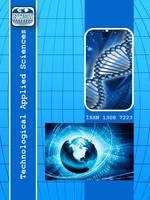SICAK DÖVME SONRASI KUMDA VE HAVADA SOĞUTULAN ÇELİKLERİN KESME KUVVETLERİ VE YÜZEY PÜRÜZLÜLÜK DEĞERLERİNİN İNCELENMESİ
Bu çalışmada, 38MnVS6 mikroalaşımlı ve 41Cr4 ıslah çelikleri kapalı kalıpta sıcak dövme sonrası kumda ve havada kontrollü olarak soğutulmuştur. Daha sonra numunelerin mikroyapı ve sertlik ölçümleri yapılmıştır. Sıcak dövme sonrası kontrollü olarak kumda ve havada soğutulan numunelerin, mikroyapı ve sertliklerindeki değişimin işlenebilirlik üzerine etkileri incelenmiştir. İşlenebilirlik deneyleri tornalama metoduyla soğutma sıvısı kullanılmadan kuru şartlarda yapılmıştır. Tornalama deneyleri kaplamalı karbür uç kullanarak kesme hızı ve talaş derinliği sırasıyla 180 m/dak ve 0.6 mm’ye sabitlenerek dört farklı ilerleme hızında (0.04, 0.08, 0.12 ve 0.16 mm/dev) yapılmıştır. Her bir numune için yukarda bahsedilen şartlarda yapılan tornalama deneyleri sonunda kesme kuvvetleri ve yüzey pürüzlülük değerleri (Ra) ölçülmüştür. Sonuçlar, farklı ortamlarda kontrollü olarak soğutulan numunelerin mikroyapı ve sertliklerinde meydana gelen değişikliklerin kesme kuvvetlerini ve yüzey pürüzlülüğünü önemli ölçüde etkilediğini göstermiştir.
Anahtar Kelimeler:
Sıcak Dövme, Mikroyapı, İşlenebilirlik, Çelik, Karbür
THE INVESTIGATION OF SURFACE ROUGHNESS AND CUTTING FORCES OF STEELS COOLED IN SAND AND AIR AFTER HOT FORGING
In this study, 38MnVS6 microalloyed and 41Cr4 heat-treatable steels were subject to a controlled cooling in air and sand after closed die hot forging. Subsequently, microstructure and hardness of the samples were measured. The effects of changes in microstructure and hardness on machinability of samples, which were controlled-cooled in air and sand after hot-forging, were investigated. The machinability test was carried out by turning method in dry conditions without using coolant. Turning tests were made by using coated carbide cutting tool at four different feed rates (0.04, 0.08, 0.12 and 0.16mm/rev) while cutting speed and cutting depth were fixed at 180m/min and 0.6mm, respectively. The cutting forces and surface roughness values (Ra) were measured for each sample at the end of turning tests which were conducted in conditions mentioned above. Results showed that changes in microstructure and hardness of samples, which were controlled-cooled in different mediums, significantly affected cutting forces and surface roughness.
Keywords:
Hot Forging, Microstructure, Machinability, Steel, Carbide,
___
- [1] Metals Handbook, (1993). Heat Treatments of Steels, 10th Edition, ASM.
- [2] Uzkut, M. ve Özdemir, İ., (2001). Farklı Çeliklere Uygulanan Değişen Isıtma Hızlarının Mekanik Özelliklere Etkisinin İncelenmesi. DEÜ Mühendislik Fakültesi Fen ve Mühendislik Dergisi, 03:65-73.
- [3] Çalıgülü, U., Aras, M. ve Türkmen, M., (2016). Temperleme İşleminin Yağda Soğutulan Çeliklerin Mikroyapı ve Sertlik Özelliklerine Etkisi. 4th International Symposium on Innovative Technologies in Engineering and Science (ISITES).
- [4] Kimura, T. ve Kurebayashi, T., (2001). Niobium in Microalloyed Engineering Steels, Wire Rod and Case Carburized Products. Proc. Int. Symp. Niobium, Orlando, FL, Vol: 1, 801–872.
- [5] Demir, H., (2008). The Effects of Microalloyed Steel Pre-Heat Treatment on Microstructure and Machinability. International Journal of Advanced Manufacturing Technology, 35, 1041-1046.
- [6] Stout K.J., (1998). Engineering Surfaces–a Philosophy of Manufacture (A Proposal for Good Manufacturing Practise). Proc. Instn.Mech.B 212, 169–174.
- [7] Rasouli, D., Sh. Khameneh, A., Akbarzadeh, A., and Daneshi, G.H., (2008). Effect of Cooling rate on The Microstructure and Mechanical Properties of Microalloyed Forging Steel. Journal of Materials Processing Technology, 206, 92-98.
- [8] Türkmen, M. ve Aras, M., (2016). Isıl İşlem Şartlarının Mikroalaşımlı Çeliklerin Mikroyapı ve Sertlik Özelliklerine Etkisi. International Sciences Symposium (ISS).
- [9] Qiao, Z.X., Liu Y.C., Yu L.M., and Gao, Z.M., (2009). Effect of cooling rate on Microstructural Formation and Hardness of 30CrNi3Mo Steel. Applied Physics A, Volume:95, pp:917-922.
- [10] Shanmugam, S., Ramisetti, N.K., Misra, R.D.K., Mannering, T., Panda, D., and Jansto, S., (2007). Effect of cooling rate on the microstructure and mechanical properties of Nb-microalloyed steels. Materials Science and Engineering A, Volume:460-461, pp:335-343.
- [11] Demir, H., Çiftçi, İ., Türkmen, M., and Gündüz, S., (2011). Orta Karbonlu Alaşımlı ve Alaşımsız Çeliklerde Isıl İşlem Şartlarının ve Sertliğin İşlenebilirliğe Etkisi. 6th International Advanced Technologies Symposium (IATS).
- [12] Demir, H., (2008). The effects of microalloyed steel pre-heat treatment on microstructure and machinability. Int J Adv Manuf Technol, Volume:35, pp:1041–1046.
- [13] Sivaramana, V., Sankaranb, S., and Vijayaraghavan, L., (2012). Machinability of Multiphase Microalloyed Steel. 11st CIRP Global Web Conference: Interdisciplinary Research in Production Engineering.
- [14] Jahazi, M. and Eghbali, B., (2001). The Influence of Hat Forging Conditions on The Microstructure and Mechanical Properties of Two Microalloyed Steel. J. Mater. Process. Tech. 113:594-598.
- [15] Gündüz, S. and Çapar, A., (2006). Influence of Forging and Cooling rate on Microstructure and Properties of Medium Carbon Microalloy Forging Steel. J. Mater. Sci. Lett. Vol. 41:561–564.
- [16] Ollilainen, V., Kasprzak, W., and Hollapa, L., (2003). The Effect of Slicon, Vanadium and Nitrogen on the Microstructure and Hardness of Air Cooled Medium Carbon Low Alloy Steels. Journal of Metarials Processing Technology, 134, pp:405-412.
- [17] Bepari, M.A., (1990). Structure of Continuously Cooled Low-Carbon Vanadium Steel. Metallurgical Transaction A, 21:2839-2855.
- [18] Karabulut, H. and Gündüz, S., (2004). Effect of Vanadium Content on Dynamic Strain Ageing in Microalloyed Medium Carbon Steel. Materials and Design 25:521-527.
- [19] Korkut, İ. ve Dönertaş, M.A., (2003). Kesme Parametrelerinin Frezelemede Oluşan Kesme Kuvvetleri Üzerine Etkileri. Politeknik Dergisi, 6(1):385-389.
- [20] Mavia, A. ve Korkut, İ., (2009). Vermiküler Grafitli Dökme Demirin İşlenebilirliğinin Deneysel Olarak Araştırılması. 5. Uluslararası İleri Teknolojiler Sempozyumu (IATS’09).
- [21] Özel, T., Hsu, T.K., and Zeren, E., (2005). Effects of Cutting Edge Geometry, Workpiece Hardness, Feed Rate and Cutting Speed on Surface Roughness and Forces in Finish Turning of Hardened AISI H13 Steel. International Journal of Advanced Manufacturing Technology, 25:262–269.
- Başlangıç: 2009
- Yayıncı: E-Journal of New World Sciences Academy
Sayıdaki Diğer Makaleler
PRODUCTION OF AA5754/B4C COMPOSITE MATERIALS BY THE SEMI-SOLID STIRRING METHOD
